Settle in the Cariboo
Settle in the Cariboo
Barkerville was the largest, and now best remembered, of many towns that flourished in the Cariboo.
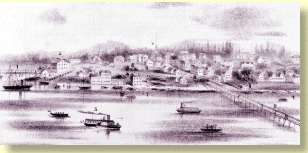
|
|
BC ARCHIVES PDP00264 Victoria, 1862 Looking from the harbour |
Elsewhere, towns like Victoria and New Westminster grew, not only because they were ports, but also because they were administrative centers.
Steamship travel developed on the lower Fraser River, the Thompson, and various lakes. Towns such as Yale and Quesnel grew because of this traffic.
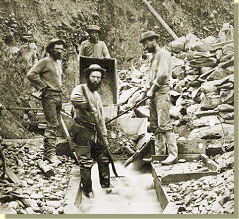
|
|
BC ARCHIVES A-00351 Ne'er Do Well Dump, Grouse Creek |
Early in the gold rush when there was no route to the creeks, each party entered the wilderness and travelled along the route they felt was best. As more and more men pressed northward, trails were gradually formed through the bush.
Along these trails grew a series of stopping places.
Many of these stopping places or "roadhouses" were established by men who decided that there were easier ways to make money than by digging for gold.
Roadhouses were constructed along the new Cariboo Wagon Road, serving as hotels and supply depots, and rest stops for horses and people.
Roadhouses were generally built in areas where grass and water were plentiful and vegetables and crops could be grown.
Those who were unsuccessful in mining often stayed in the Cariboo in the roadhouse business to become the first pioneers in the new agriculture and business communities.
Many of the roadhouses were built by road contractors. Individual contractors were awarded a contract to construct specific miles of road from Yale to Barkerville.
Many of the houses gained their names from mile posts along the Wagon Road.
The roadhouses took their names from mileage measured from Lillooet, which was the point of departure on the first Cariboo Road of 1859.
For example, after choosing a logical place for a roadhouse, they would name it 70 Mile House since it was 70 miles from Lillooet.
Eventually roadhouses were to average from 10-15 miles apart but in some areas there was one every 3-4 miles.
Since the services at the stopping places depended on those in charge, the quality of food, cleanliness of beds, and overall hospitality varied greatly.
It was not until rich strikes were made on the upper Fraser River and in the Cariboo that better routes to the gold-fields became a priority. In May 1862, the Royal Engineers commenced construction of the Cariboo Wagon Road.
The Royal Engineers completed the 365-mile long Cariboo Wagon Road in 1865. What had been a long hard trip to the Cariboo gold-fields was now relatively fast and easy.
A passenger could now travel from Victoria to Yale by steamship, and from Yale to Barkerville by stagecoach.
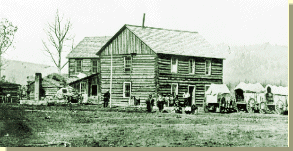
BC ARCHIVES A-03907
161 Mile House, Deep Creek
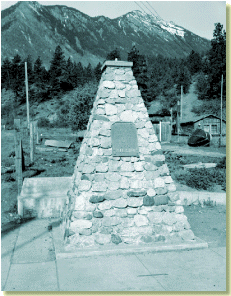
BC ARCHIVES I-22310
Mile 0 Marker, Cariboo Highway
Lillooet
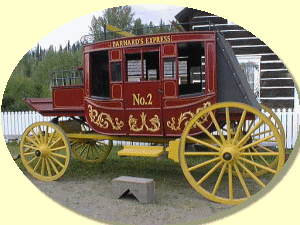
Replica of Barnard's Express stagecoach
Cottonwood House 1998



|
Last updated November 30, 1998. Produced by Carollyne Yardley Industrial Art Internet Group Ltd. © 1998-2002 |
